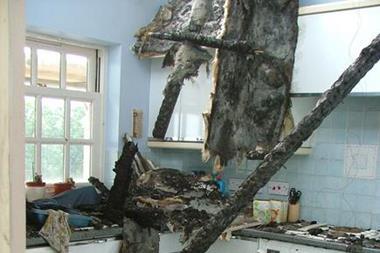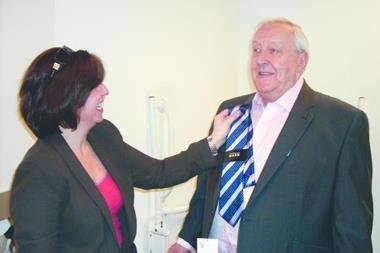Crawford has entered the complex world of psychological profiling with the appointment of a specialist investigator to help its counterfraud team. We meet insurance’s answer to Clarice Starling, Nikki Grieve-Top
A brief look at the daily listings of TV dramas might convince you that crime-busting investigative psychologists are 10-a-penny these days. So much so that when Nikki Grieve-Top started her training in investigative psychology, her mentor warned the class on day one of the course: “If you think you’re going to end up like Cracker, just leave now.”
She laughs at the memory, but adds that these shows, with their resourceful, nearly telepathic characters, fuel misconceptions about the profession. “People think we have this ability to read into the future; that we can pull research out of thin air,” she says.
Investigative psychologists have certainly been a rarity in the insurance industry. But change is in the air. In an industry first, loss adjuster Crawford & Company has appointed Grieve-Top to the new role of claims psychology director. It hopes her psychological techniques will improve understanding of policyholders’ behaviour and, most importantly, help root out fraud.
The industry needs all the help it can get. The ABI estimates that undetected fraud now costs insurers more than £1bn a year.
A trained investigative psychologist, Grieve-Top specialises in the “systematic, scientific investigation of financial crime and fraud”. During her psychology degree, she found she was drawn to criminal and legal issues, becoming a research assistant at the Centre of Investigative Psychology in Liverpool and going on to head insurer Saga’s fraud team.
As part of her remit at Crawford she will train staff in “conversation management”– an investigative interviewing technique that helps determine whether people are telling the truth. She says that while it is easy to detect an implausible story, spotting a well-rehearsed lie is a lot trickier.
She believes staff should concentrate on the characteristics of truth telling. First, she says, it is vital to adopt a conversational tone and ask open questions, putting the onus back on the policyholder to explain exactly what occurred.
“It is about rewording the questions. If you say: ‘You spilled the cup of coffee; so the cup fell towards you?’, the answer is going to be yes or no. Instead, you should say: ‘Can you describe to me how the cup fell?’. To investigate, you need to listen, not make a decision about what happened,” she explains.
It is important to understand the mechanics of memory, she says. “People simply do not tell stories in chronological order, because of the way we store information in our memory. When we go to bed our brains have to restructure and reorganise that information, and by doing that our memories become disjointed.”
As a result, when people first play back the information in speech they will rarely recount the exact sequence of events, and will be prone to making spontaneous corrections.
As well as the structure of the story telling, there are other areas investigators should watch out for: emotions, extra details and inadvertent slips of the tongue.
To demonstrate how conversation management can be used successfully, Grieve-Top refers to one claims case in which a policyholder alleged that paint had been spilt on a couch.
“This individual didn’t seem to really have much in the way of detail when he was describing his story. He was trying to tell us on the phone that paint had been spilt on his sofa and he was blaming his cat for it,” she says.
The policyholder slipped up when he said the paint “absolutely stank”. “Modern paints are often odourless and when the investigator probed, it turned out it wasn’t paint at all – the cat had urinated on the sofa. But this was not covered under the terms of the policy,” Grieve-Top says.
Such cases of opportunistic fraud have spiralled in the recession. “It is just a typical story – of somebody trying to get something they are not entitled to by lying,” she says.
Organised gangs
Profiling professional fraudsters in organised gangs presents a greater challenge. “Criminal networks are a big problem,” Grieve-Top says. “It has been going on for 10 or 15 years; it’s just that we are now much more aware of it,” she says.
Gangs constantly change their tactics to stay one step ahead of investigators who are trying to pinpoint vehicles and names, or build up a profile of a criminal. Grieve-Top says organised motor fraudsters have begun using people to carry out their scams who do not conform to the sterotypical view of a gang member. “If Jane Smith and John Jones are in a vehicle at a certain time of night in a certain location, we are not going to pick them up as being linked to a particular gang because they don’t fit the profile,” she says. “That is the danger of just looking at profiles: they keep changing.”
To help investigators stay on top of this, they must cast aside any preconceptions or bias when they are interviewing. One of Grieve-Top’s aims is to help staff be more aware of the factors that influence their own thought processes.
“If I have an internal perception of how a fraudster should look – a certain age, a certain profile – my interview strategy will be to try and prove this is right,” she explains. This closed approach inevitably makes it much harder to pin down the seemingly law-abiding Jane and John.
Forensic approach
Claims can also be verified using forensic aids such as “splatter analysis”: the fraud team applies techniques typically used to examine bloodshed in criminal cases to help them assess spillages such as paint or wine.
Recreating claims scenarios can also help investigators get a sense of what a genuine claimant would have felt and test how plausible their explanations are. As part of her training, Grieve-Top was involved in the reconstruction of fire scenes.“I didn’t understand until then the heat, smell and velocity.”
She says that images showing scenes before a fire, the different stages during a fire and its aftermath can be useful as a psychological and visual tool.
“These are areas that people in our first notification of loss teams need to understand,” she explains. “Then they can understand the risk and direct certain claims to the fraud unit or fast-track genuine claims. It is that kind of learning we should be passing on.”
She concedes that the industry has become much better at data sharing but believes there is still room for improvement in the fragmented management of data.
“I don’t believe there is one single supplier where I could get a field investigation, a desktop investigation and a data matching and mining process.”
But while inroads have been made in the detection of motor fraud, other areas of insurance are at risk of neglect, she says. “The Insurance Fraud Bureau is a great solution for motor, but what about my travel book, my liability book, my commercial book, my subsidence book? These are all areas that the fraudsters are going to be hitting.”
Grieve-Top says she has always been fascinated by human behaviour and what compels people to do things. She jokes that a childhood obsession with Cluedo may have had something to do with her career path.
Now the industry could be about to reap the benefits of this fascination in its bid to stay one step ahead of fraud. IT






































No comments yet